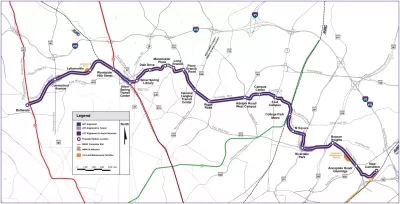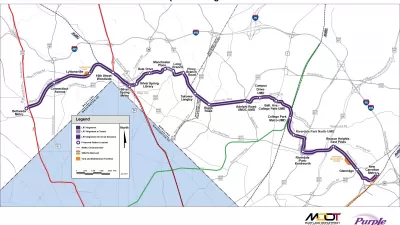Montgomery County planners recommend the implementation of sidewalks, crosswalks, and bike lanes on streets within a half-mile radius of Purple Line light-rail stations.

According to a new study conducted by planners in Montgomery County, Maryland, suburban streets surrounding Purple Line stations need improved sidewalks and crosswalks to allow safer access for pedestrians. Purple Line riders are expected to access the train primarily on foot as the stations are designed to utilize only existing parking infrastructure. "With most Purple Line passengers expected to reach stations by walking, in addition to bus, making surrounding roads more comfortable for pedestrians will be key to their safety and willingness to use the new light-rail system," reports Katherine Shaver.
Within a half-mile radius of the ten Purple Line stations in the county, planners found that most streets have too narrow or no sidewalks as well as a similar lack of marked crosswalks. Shaver says the planners recommend a speed reduction from 30-40 mph to 25 mph within the half-mile radius from stations. Improving the pedestrian-friendliness of the streets in the car-dominated suburbs will include widening sidewalks, adding bike lanes, increasing visibility of crosswalks, and landscaping to create a buffer between cars and pedestrians. Shaver says "planners recommend prioritizing improvements in communities with lower household incomes and more minority residents because they have some of the most dangerous walking conditions and have been underserved historically."
FULL STORY: Purple Line stations need safer access for pedestrians, planners say

Trump Administration Could Effectively End Housing Voucher Program
Federal officials are eyeing major cuts to the Section 8 program that helps millions of low-income households pay rent.

Planetizen Federal Action Tracker
A weekly monitor of how Trump’s orders and actions are impacting planners and planning in America.

Ken Jennings Launches Transit Web Series
The Jeopardy champ wants you to ride public transit.

California Invests Additional $5M in Electric School Buses
The state wants to electrify all of its school bus fleets by 2035.

Austin Launches $2M Homelessness Prevention Fund
A new grant program from the city’s Homeless Strategy Office will fund rental assistance and supportive services.

Alabama School Forestry Initiative Brings Trees to Schoolyards
Trees can improve physical and mental health for students and commnity members.
Urban Design for Planners 1: Software Tools
This six-course series explores essential urban design concepts using open source software and equips planners with the tools they need to participate fully in the urban design process.
Planning for Universal Design
Learn the tools for implementing Universal Design in planning regulations.
Ada County Highway District
Clanton & Associates, Inc.
Jessamine County Fiscal Court
Institute for Housing and Urban Development Studies (IHS)
City of Grandview
Harvard GSD Executive Education
Toledo-Lucas County Plan Commissions
Salt Lake City
NYU Wagner Graduate School of Public Service




























